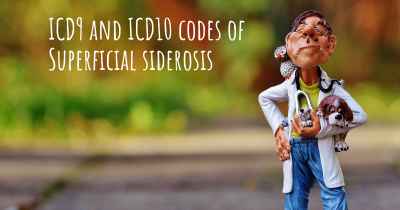Is Superficial siderosis hereditary?
Here you can see if Superficial siderosis can be hereditary. Do you have any genetic components? Does any member of your family have Superficial siderosis or may be more predisposed to developing the condition?

Superficial siderosis is a rare neurological condition characterized by the deposition of iron in the superficial layers of the brain and spinal cord. While the exact cause is not fully understood, it is believed to be primarily acquired rather than hereditary. However, in some cases, a genetic predisposition may play a role in the development of the condition. Further research is needed to fully understand the genetic factors involved in superficial siderosis.
Is Superficial Siderosis Hereditary?
Superficial siderosis is a rare neurological condition characterized by the deposition of iron in the superficial layers of the brain and spinal cord. It is typically caused by chronic bleeding in the subarachnoid space, which surrounds the brain and spinal cord. The iron deposits gradually lead to damage of the nervous system, resulting in various symptoms such as hearing loss, balance problems, cognitive decline, and neurological deficits.
When it comes to the hereditary nature of superficial siderosis, research suggests that it can be both inherited and acquired. Let's delve into the details:
Inherited Superficial Siderosis:
There are rare cases where superficial siderosis is caused by genetic mutations that are passed down from parents to their children. These genetic mutations affect the body's ability to regulate iron metabolism, leading to iron accumulation in the brain and spinal cord. Inherited superficial siderosis is typically inherited in an autosomal recessive manner, meaning that both parents must carry the mutated gene for their child to develop the condition.
Genetic studies have identified specific gene mutations associated with inherited superficial siderosis. These mutations affect genes involved in iron transport and metabolism, such as the HFE gene. However, it is important to note that these genetic mutations are extremely rare, and most cases of superficial siderosis are not inherited.
Acquired Superficial Siderosis:
The majority of superficial siderosis cases are acquired rather than inherited. Acquired superficial siderosis occurs when there is chronic bleeding in the subarachnoid space, leading to the deposition of iron in the brain and spinal cord. The bleeding can result from various causes, including:
- Traumatic brain injury
- Brain or spinal surgery
- Spinal cord injury
- Arteriovenous malformations (AVMs)
- Brain tumors
- Chronic subdural hematomas
- Recurrent episodes of subarachnoid hemorrhage
These underlying conditions can cause ongoing bleeding, which gradually leads to the accumulation of iron and the development of superficial siderosis.
Genetic Predisposition:
While most cases of superficial siderosis are acquired, there may be a genetic predisposition that makes certain individuals more susceptible to developing the condition. This means that even in acquired cases, some individuals may have a genetic susceptibility that increases their risk of developing superficial siderosis when exposed to certain triggers.
Research is ongoing to better understand the genetic factors that may contribute to this predisposition. Identifying these genetic markers could help in identifying individuals at higher risk and potentially developing preventive measures or targeted treatments.
Conclusion:
In summary, superficial siderosis can be both inherited and acquired. Inherited cases are extremely rare and are caused by specific genetic mutations that affect iron metabolism. Acquired cases are much more common and result from chronic bleeding in the subarachnoid space due to various underlying conditions. While most cases are acquired, there may be a genetic predisposition that increases the risk of developing superficial siderosis. Further research is needed to fully understand the genetic factors involved and their implications for diagnosis, treatment, and prevention.
Posted Sep 24, 2017 by BonbonSW 200








